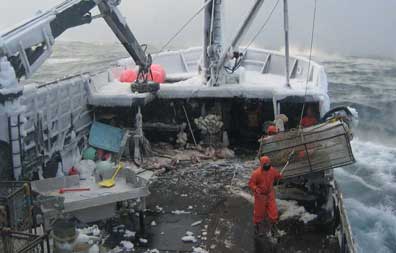NIOSH Research Cited in Recommendations for Improving Commercial Fishing Safety
March 2012
DHHS (NIOSH) Publication Number 2012-129

A typical day crab fishing on the Bering Sea in Alaska. Photo courtesy of Mike Fourtner.
A Story of Impact:
Commercial fishing is, by any measure, a dangerous occupation. Brutal environmental conditions lead to hazards in every part of the work environment: slip/trip hazards, contact injuries from fishing gear entanglement, vessel losses and falls overboard.
In 1990, NIOSH began working closely with industry partners to address the high number of fishing fatalities in Alaska. By focusing on fishery-specific hazards such as vessel overloading in the crab fleet, fatality rates have been reduced 42%.1 Beginning in 2007, NIOSH expanded this approach to identify specific regional hazards for the rest of the country by collecting risk factor information for fatalities and creating the Commercial Fishing Incident Database. In 2008, NIOSH researchers conducted a personal flotation device (PFD) study with over 400 fishermen to identify PFDs that are comfortable to work in for several gear types.
These rate reductions and high profile research programs with industry partners set the stage for NIOSH’s opportunity to affect fishing safety policy on a national level.
Relevant Information
- Commercial fishermen have the deadliest occupation in the United States.2 From 2000-2010 the fatality rate for commercial fishermen (fishers) was 124 per 100,000 compared to 4 per 100,000 for all other occupations.
- The two leading causes of death are vessel disasters (51%) and falls overboard (31%).1
- Of the 170 man overboard fatalities between 2000 and 2010, noneof the victims were wearing a personal flotation device (PFD).1
Impact
The NTSB recommendations to the US Coast Guard include the requirement for training in stability for vessel owners and skippers, and mandatory use of flotation aids for workers while on deck. Skippers and crew are also encouraged to be trained in man overboard recovery techniques and show certification in these areas prior to each season. Enactment of these recommendations would support the long-term NIOSH National Occupational Research Agenda (NORA) goals to reduce vessel sinking and man overboard fatalities in commercial fishing by 50% by 2018.4
NIOSH researchers continue to work with industry, safety personnel, US Coast Guard, and policy makers to improve occupational safety for commercial fishermen. Ongoing efforts include collection and analysis of nationwide fatality data, development and evaluation of engineering interventions to prevent vessel loss from downflooding and instability, and communication efforts to encourage use of PFDs while working on deck. These research-to-practice measures and collaborative efforts will improve the safety of fishermen nationwide and insure safe and productive seasons in all fisheries around the country.
View/Download Entire Document: NIOSH Research Cited in Recommendations for Improving Commercial Fishing Safety pdf icon[PDF – 229 KB]




For more Information on commercial fishing safety:
Visit www.cdc.gov/niosh/topics/fishing for more information about research efforts to reduce fatalities in the commercial fishing industry. NIOSH has published a collection of regional fatality summaries for the commercial fishing industry highlighting specific regional hazards; electronic copies can be downloaded on the commercial fishing website. For copies of those and other NIOSH commercial fishing safety publications visit our website. You can also follow the commercial fishing safety program on Twitter: @NIOSHFishing.
References
1 NIOSH [2011]. Commercial Fishing Incident Database. Maintained by the NIOSH Alaska Pacific Office. Accessed March 8, 2012.
2 Bureau of Labor Statistics, 2011. National Census of Fatal Occupational Injuries in 2010.pdf iconexternal icon Available from: http://www.bls.gov/news.release/pdf/cfoi.pdf (retrieved March 8, 2012)
3 NTSB [2011]. NTSB Safety Recommendations for Commercial Fishingpdf iconexternal icon (http://www.ntsb.gov/doclib/recletters/2011/M-11-023-027.pdf)
4 NORA [2008]. National Agriculture, Forestry, and Fishing Agenda.pdf icon Pp. 61-61. (https://www.cdc.gov/nora/comment/agendas/AgForFish/pdfs/AgForFishDec2008.pdf)
SAFER • HEALTHIER • PEOPLE™
